“USA 🇺🇸 ~Road Trip’n Through Nebraska and into South Dakota to Visit The Badlands National Park, Wind Cave National Park and More!”

We are having a phenomenal road trip! If you are following us, I think you may agree.
Because our current focus is to get to the East Coast, from the West Coast, to see our grandchildren; on this visit home from overseas, our time constraints are limited, so we are being selective with our stopping and visiting, of specific sites. We didn’t miss a thing and especially loved our visit to South Dakota
******
SOUTH DAKOTA
South Dakota is an expansive, sparsely populated midwestern U.S. state where rolling prairies give way to the dramatic Black Hills National Forest. Black Hills is home to two historical monuments carved right into towering granite peaks: Mt. Rushmore, the iconic depiction of four revered U.S. presidents, and Crazy Horse Memorial, a tribute to the storied Native American tribal leader.


I’ve wanted to visit South Dakota for so many years, but never got there. Daryl had not been, either, so it was all new to both of us.
Until South Dakota, I had been to 48 states. South Dakota made my 49th state visit. It was jammed packed with amazing sites and we saw everything we wanted to see at this time. We loved this state!
When we first arrived in South Dakota, we planned a two-night stay to play “catch up” on all our photos and writing, and to rest, before exploring. We’ve been on the go in the USA for a steady 1.5 months. I didn’t exactly get caught up, but I’m less behind.
***********
So, we’ve been in three states today: Colorado, Nebraska and South Dakota! We just crossed into North Dakota and were stopped at a checkpoint. They wanted to see if we were sick with Covid symptoms.
No state we’ve driven through has done that ⬇️

************
We are also finding there is a coin shortage across the states.
Drive-up food places require exact change or credit card. ⬇️
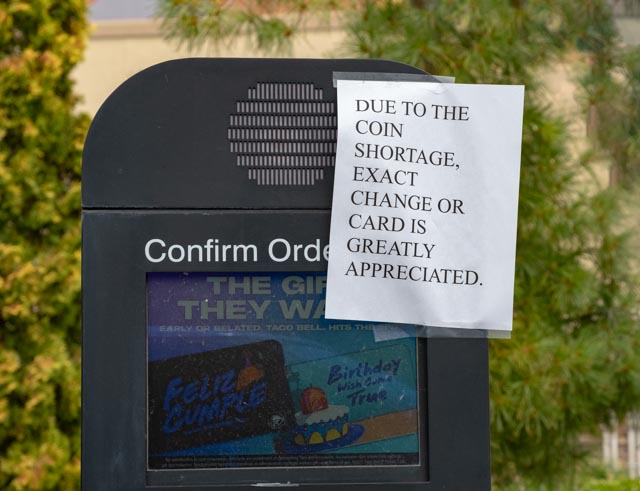
***********
After the checkpoint, we had one shot at a B &B, but they were fully booked. So, we have to go back to Nebraska to get a room, ha! We had just enough daylight. We will make it, to the Badlands, tomorrow.
***********
My view while drinking my coffee the next morning ⬇️
No, not a great picture, but for me, a great meaning. I am moved by the display of the Red, White and Blue, all around this country. I am so proud to be an American!

AND…America is so wonderful!
**Let’s remember to pray for those who are hurting:
Last night, just at dusk, we did find a hotel in a remote town of Gordon, Nebraska. The woman said she needed to clean the room she did have available. No problem, we waited. When done, Daryl went to the office and officially checked us in. In speaking with the woman, she expressed how she can’t find any help to hire. Nobody wants to work, since they make more money on unemployment. (Truth: we see “for hire” signs everywhere, in every state we drive through, and this is the same story we hear from other business owners).
Anyway, this one-woman show is barely keeping up, since her husband died a month ago from a heart attack (non C19 related). She looks so tired. I wish we could do more, but we can pray for her.
Prayer works. God hears our prayers.
************
THE BADLANDS NATIONAL PARK

Located in southwestern South Dakota, the Badlands National Park consists of 244,000 acres of sharply eroded buttes, pinnacles and spires, blended with the largest, protected mixed grass prairie in the United States. The Badlands Wilderness Area covers 64,000 acres and is the site of the reintroduction of the black-footed ferret, the most endangered land mammal in North America.
The Stronghold Unit is co-managed with the Oglala Sioux Tribe and includes sites of the sacred 1890s Ghost Dances.
Established as the Badlands National Monument in 1939, the area was re-designated a “National Park” in 1978.
Over 11,000 years of human history pale to the ages-old paleontological resources. Badlands National Park contains the world’s richest Oligocene epoch fossil beds, dating back to 23 to 35 million years old.
Scientists can study the evolution of mammal species such as the horse, sheep, rhinoceros and pig in the Badlands formations.

Yes, the Badlands were windy!
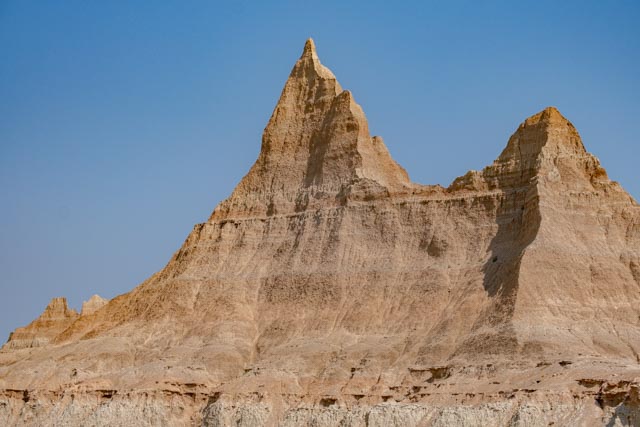




Bighorn Sheep
The Badlands are home to several kinds of herd animals. Mule deer are by far the most common animal to see on a drive through the park, but some visitors may also see white-tailed deer.
Visitors should keep their eyes peeled for three less common animals of the Plains: bison, bighorn sheep, and pronghorn.
On our visit, we saw the less seen wildlife, including Bison. We did not see other wildlife, here. The Buffalo we saw were in the distance, not up close.
We we’re not charged to enter the park. We enjoyed a large wildlife loop. There was some haze, so photos were challenging. Not sure what caused it.


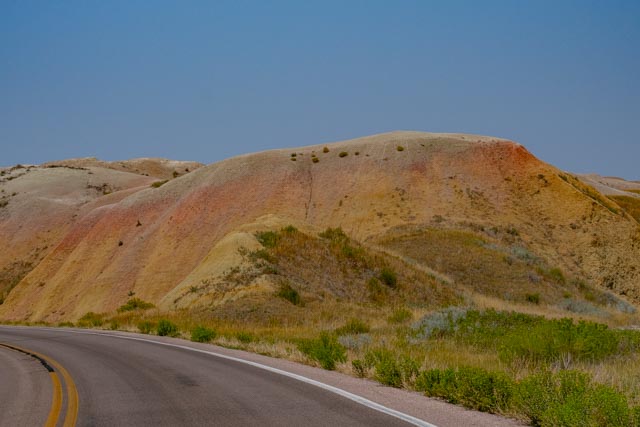






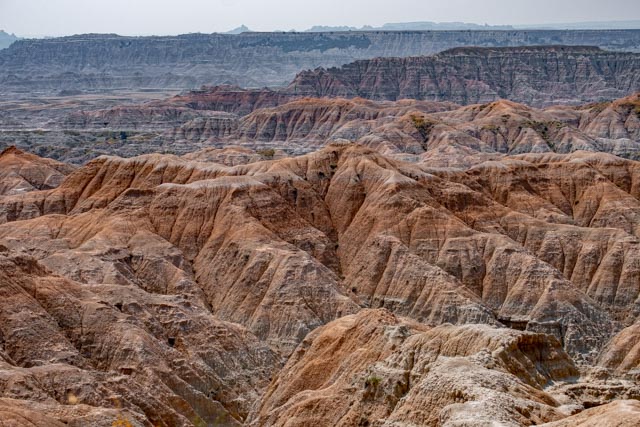
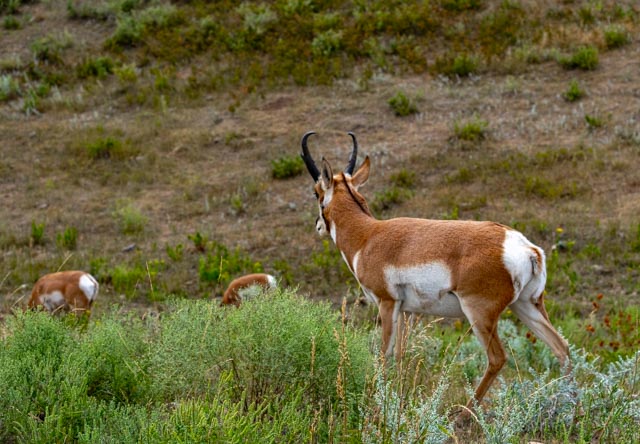
Pronghorn

White Tail Deer, Keeping Cool


Roberts Prairie Dog Town

Prairie dogs are herbivorous burrowing rodents native to the grasslands of North America. The five species are: black-tailed, white-tailed, Gunnison’s, Utah, and Mexican prairie dogs. They are a type of ground squirrel, found in North America.


**************
THE TOWN OF CUSTER



Replicated Pioneer Fort.
We didn’t go inside. I watched Daniel Boone when I was kid. I know what the inside looks like. 🤩


**************
CUSTER STATE PARK
Custer State Park is famous for its Buffalo herds, other wildlife, scenic drives, historic sites, visitor centers, fishing lakes, resorts, campgrounds and interpretive programs. In fact, it was named as one of the World’s Top Ten Wildlife Destination, for the array of wildlife within the park’s borders and for the unbelievable access visitors have to them.
One of the nation’s largest state parks, just 15 miles from the city of Custer, South Dakota’s premier State Park comprises 71,000 acres.
Custer State Park has been home to diverse cultural heritages for thousands of years and has provided an array of scenic beauty and outdoor recreation for visitors since the early 1900s.
We paid $20 for a 7-day pass. We made two visits.





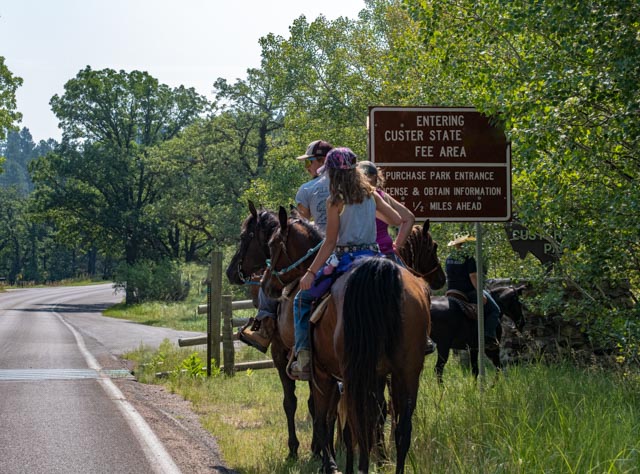
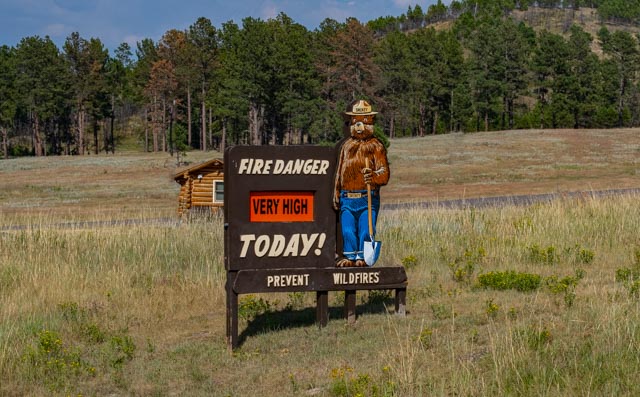

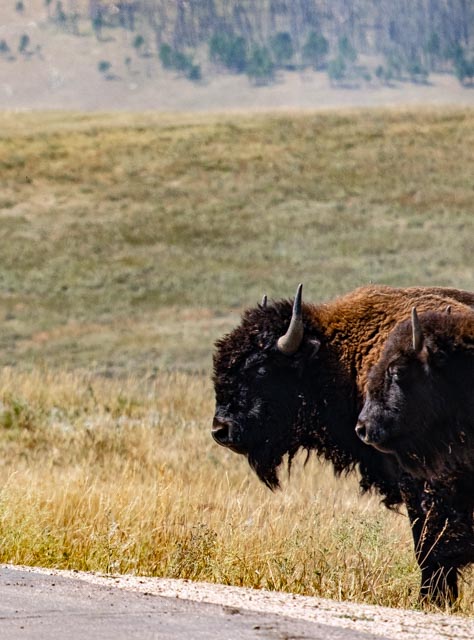
The park is home to nearly 1,500 head of North American Bison. Commonly known as Buffalo, these massive mammals can grow to 6 feet tall and weigh more than 2,000 pounds.
Other watchable wildlife include whitetail and mule deer, antelope, mountain goats, elk, coyotes, burros, bighorn sheep, birds, wild turkeys and prairie dogs. Mountain lions and bobcats are also found in the park, but they are nocturnal and reclusive toward humans. Whether you’re a casual sightseer or a serious nature photographer, the critters of Custer Sate Park put on quite a show. Most wildlife can easily be seen from your car. Bear in mind, they are wild. Keep your distance.
Custer State Park offers a unique state park opportunity. Please protect your park so it is enjoyable for everyone. All natural and cultural resources are protected. Picking up antlers, rocks or artifacts, collecting plants, feeding or disturbing wildlife is prohibited.


Bison are the park’s biggest attraction but remember these animals are dangerous, so please give them plenty of space. While hiking, biking or horseback riding in Custer State Park, visitors should be aware of prairie rattlesnakes, ticks and poison ivy.
Campers and hikers should never drink water from lakes, streams or springs in Custer State Park.



Pronghorn
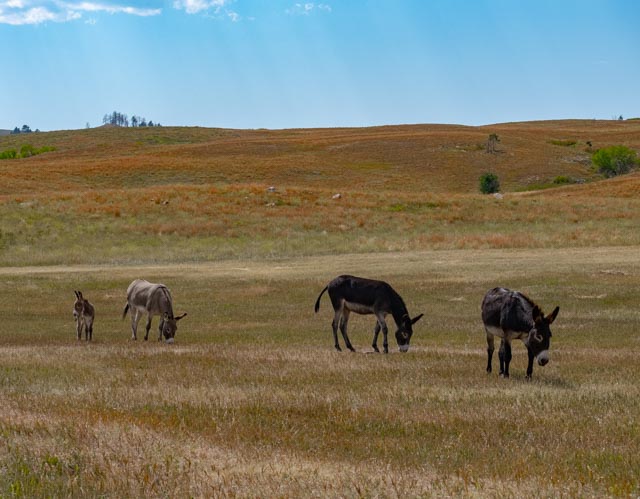
These animals have roamed the expanses of Custer State Park for nearly a century, when they were first used as pack animals to get visitors from Sylvan Lake Lodge up the steep path to the summit of Black Elk Peak, the highest point in the U.S. east of the Rockies. When those tourist trips ended, the working burros were released to the wild and the tiny feral herd has since shared the park with neighbors, including whitetail and mule deer, wild turkeys, elk, antelope, bison, and coyote.


After several tough months for the Burros in Custer, this year hasn’t been all bad news for the begging burros. Just three months after the snake bite felled the lone burro, and a fire before that killed three and injured many more, Custer State Park announced its newest resident. A baby Burro, who is learning very quickly from her mom, how to beg, and let visitors love on her.

While bison herds, rippling trout streams, scenic drives and towering granite spires rising from the forest floor garner most of the attention from visitors, nowhere will you feel more welcomed than during a chance encounter with the park’s infamous “begging burros.”





***********
CRAZY HORSE
A Lakota Sioux warrior, a famed artist, his family and a canvas composed of granite, are the elements that comprise the legendary past, present and future of the Crazy Horse Memorial.
Sculptor; Korczak Ziolkowski began the world’s largest mountain carving in 1948. Members of his family and their supporters are continuing his artistic intent to create a massive statue that will be 641 feet long and 563 feet high, upon completion. To give that some perspective, the heads at Mount Rushmore National Monument are each 60 feet high.
Workers completed the carved 87½-foot-tall Crazy Horse face in 1998, and have since focused on thinning the remaining mountain to form the 219-foot-high horse’s head.
Crazy Horse Memorial hosts between 1 and 1½ million visitors a year. The number of foreign travelers, particularly group tours from Asia, are increasing.
The Indian Museum of North America, and the adjoining Welcome Center and Native American Educational and Cultural Center, feature more than 12,000 contemporary and historic items, from pre-Colombian to contemporary times.
The new Mountain Museum wing helps explain the work behind the scenes, augmenting the introductory “Dynamite & Dreams” movie at the Welcome Center.
We chose not to pay the $35 pp and just took photos from a distance. It was plenty for us.





***********
MOUNT RUSHMORE MONUMENT
Mount Rushmore symbolizes the ideals of freedom, democracy and the American dream in the four 60-foot granite faces. This mountain carving of Presidents George Washington, Thomas Jefferson, Theodore Roosevelt and Abraham Lincoln draws over three million visitors a year. It is both a spectacular site and a man-made wonder.
The first blast on the mountain occurred in 1927. Under the direction of sculptor; Gutzon Borglum, 400 men and women worked through hot summers and cold winters to create the 60-foot faces, nearly 500 feet up the side of the mountain. Over 90% of the mountain was carved using dynamite. The fine details of the faces were achieved, using jackhammers and hand chisels. Operators hung from the top of the mountain in bosun chairs held by steel cables.
Despite the dangerous work, in the 14 years it took to carve the mountain, not a single person died. The memorial was officially declared complete on October 31, 1941.
We paid a few dollars for parking, but walking a short distance for entering the monument, was free.







In 1927, sculpting began on the face of Abraham Lincoln
***********
Wind Cave National Park
We did not chose to spend time going into the cave, below the ground, and just enjoyed what this Park has to share, above ground. We have gone underground to see many, many caves, all around the world, and they don’t look all that different.
Above ground is 33,970 acres of wildlife sanctuary where visitors can spot bison, prairie dogs, pronghorn, deer, elk and even a wily ferret or two! Be prepared for a “South Dakota traffic jam,” but don’t worry. That just means some bison are casually crossing or lingering on the road, offering a unique opportunity to witness these magnificent animals with your own eyes.
The forested hillsides and rolling prairie grasslands of Wind Cave National Park offer ample space to wander and take in the majesty of nature. The park’s two main paved roads — US Hwy 385 and SD Hwy 87, offer the easiest way for visitors in vehicles to explore the Park, but two gravel roads: NPS 5 and NPS 6, allow for some backcountry exploration. Passenger vehicles and bikes are limited to park roads, but hiking is allowed throughout the area. Visitors can go backcountry camping in the park’s northwest area (north of Beaver Creek, east of Highway 87, south of NPS 5, and west of Highland Creek Trail). Make sure to get your free camping permits, from the visitor center before heading out for a unique and peaceful night in the wilderness.
The park is also home to Beaver Creek Bridge, a 225-foot-long bridge built in 1929 to provide travelers with easier access to what would become Custer State Park. What’s especially impressive about this bridge is its design. Not only is it the only one in the state with its specific arch type, it was also made to look as if the concrete arches are rising naturally from the canyon’s rock walls.
While the area may be best known for the cave below, Wind Cave National Park’s open and verdant landscapes offer truly extraordinary opportunities to hike, bike, cruise, view wildlife and take in some of the country’s finest wide-open spaces.
The Needles Highway in the Black Hills is Very Scenic
The Needles at Custer State Park, have become one of the park’s biggest attractions. These soaring, slender granite rock formations attract visitors from near and far alike. Hike through Custer State Park and see the Needles for yourself. This attraction has also become a popular rock-climbing spot.
Looking for incredible views? Needles Highway features 14 miles of scenic views through Custer State Park. Check out these famed natural structures as you cruise past forests, meadows, mountains and Sylvan Lake.
That being said, driving the twisty curvy road with limited pull outs, looking for the Needle, and other spires was tough. This may be in part, due to the over growth of the beautiful forest.
Hiking appears to be the only way to see all the sites mentioned. We enjoyed the drive just fine and recommend it.




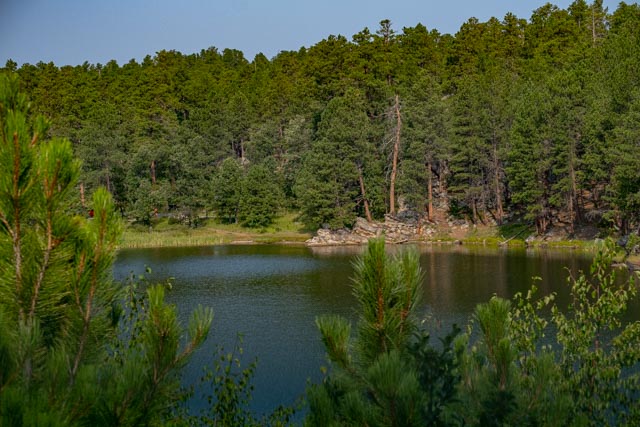



************
STURGIS
Sturgis is a city in western South Dakota. The Sturgis Motorcycle Museum & Hall of Fame nods to the city’s long-running Sturgis Motorcycle Rally and houses vintage motorbikes, plus memorabilia and photographs.
The rally began in 1938, by a group of Indian Motorcycle riders and was originally held for stunts and races.
Fort Meade, a 19th-century military outpost, and the Old Fort Meade Museum, documenting its history, are just east of town.
To the south, Black Hills National Forest has rugged mountains, canyons and trails.

*************
VISITED STATES ON ROAD TRIP:
CALIFORNIA: ✅
NEVADA: ✅
OREGON: ✅
KONA, HAWAII: ✅
OREGON again: ✅
IDAHO: ✅
UTAH: ✅
WYOMING: ✅
COLORADO: ✅
NEBRASKA: ✅
SOUTH DAKOTA: ✅



NOTE:
From the town of Custer, Custer State Park, the Needles Hwy, Crazy Horse and Mount Rushmore are in close proximity of each other.

SOUTH DAKOTA

NEBRASKA

COLORADO

The United States
Archive Blog Posts of Our Country Visits
About Us

About Us
Hello and Welcome to our Travel Blog Website, We enjoy writing about our experiences and taking photos of our adventuring along the way. Our names are: Daryl and Pen, but Daryl calls me “Bunny.” We met, quite randomly, whilst both… Read More










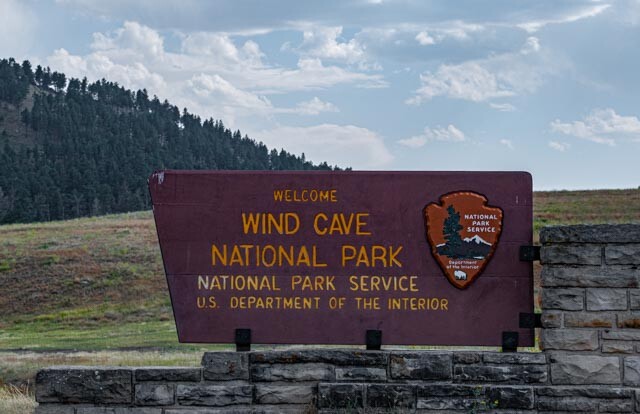

Love traveling with you, what a glorious country we are blessed to call home!! ❤️
Thanks Laurie. We feel the same way, and doing this trip has re-energized us even more!